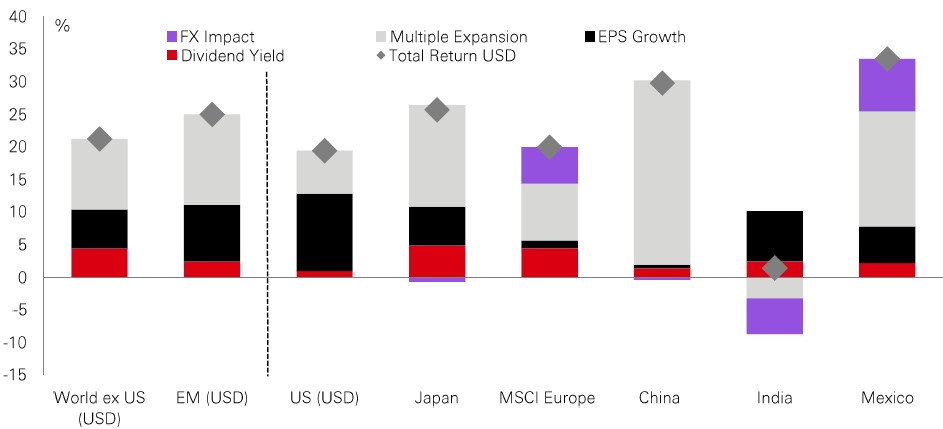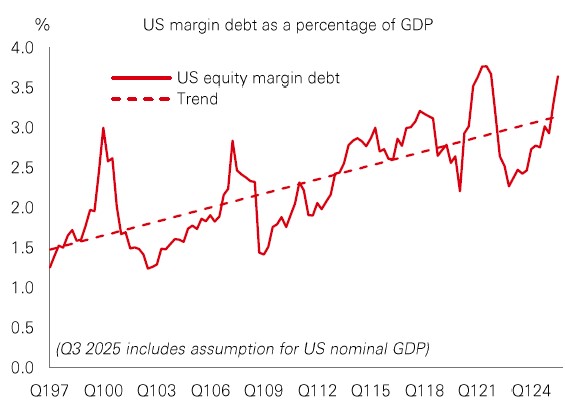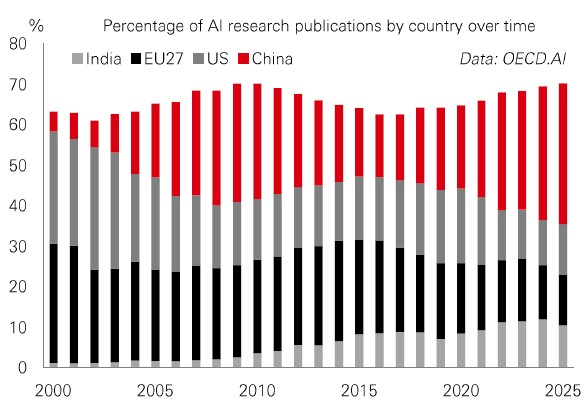
1 December 2025

The macro and market environment in 2025 has been characterised by resilient growth, moderating (though sticky), inflation, policy uncertainty, and broadly positive markets. So, what is the outlook for next year?
For a start, global markets have been driven by improving sentiment this year – helped by fading US exceptionalism and a weaker dollar. Price-to-earnings multiples in stocks have expanded, and corporate credit spreads have reached decade-lows. But with valuations no longer a tailwind, and further big falls in the dollar not guaranteed, 2026 performance will be much more dependent on profits growth and credit fundamentals.
Secondly, the US’s role as a growth leader faces challenges. While tech investment is driving growth, other key parts of the economy – like employment and consumer spending – are fragile. So, growth rates across western economies are expected to come together next year, with the fastest growth still in Asia, the Gulf, and Frontier regions.
Thirdly, emerging market central banks have had space to ease policy ahead of the Federal Reserve this year. Faced with sticky inflation, further Fed cuts look achievable in 2026, with similar easing likely in Europe. And while EM policymakers are expected to cut too – next year, it will be more a case of them following the Fed than leading it.
Overall, a shifting macro and policy backdrop is consistent with changing characteristics of key asset classes.
Performance in the private credit market has been strong this year, with high single-digit annual gains, rapid market growth, and abundant liquidity. And while returns could moderate in response to falling rates in 2026, some alternative investment experts expect them to remain robust. Moreover, investors are increasingly being drawn to “multiple engines” in the asset class, including compelling risk-adjusted returns, diversification, and income stability.
Part of the appeal of private credit is its low correlation to public markets, which makes it a potential diversifier to conventional stocks and bonds. Intra-asset class diversification plays a part, too. Direct lending (the largest private credit sub-category), for example, has a higher-risk, higher-reward profile given its specialisation in providing loans to private equity-backed firms. But infrastructure debt, another key part of the market, is more defensive, given its focus on financing projects in areas like transportation, energy transition, and digitalisation.
In the context of recent signs of credit stress in parts of the market, a focus on high quality and the role of private credit as a portfolio diversifier are key. With the recent industry data suggesting that default rates are still low overall, it underscores the asset class’s defensive appeal.
The value of investments and any income from them can go down as well as up and investors may not get back the amount originally invested. Past performance does not predict future returns. The level of yield is not guaranteed and may rise or fall in the future. For informational purposes only and should not be construed as a recommendation to invest in the specific country, product, strategy, sector, or security. Diversification does not ensure a profit or protect against loss. Any views expressed were held at the time of preparation and are subject to change without notice. Any forecast, projection or target where provided is indicative only and is not guaranteed in any way. Source: HSBC Asset Management, Bloomberg, Macrobond. Data as at 7.30am UK time 28 November 2025.
The UK’s public finances have been in the headlines lately. However, the country’s fiscal problem is more of a productivity problem. Since the global financial crisis, productivity has been poor, and supply side shocks and worsening demographics have lowered potential growth. The upshot is that tax revenues have disappointed and public spending has risen. In the Autumn Budget, the Chancellor attempted to fix the situation by raising taxes, albeit with most measures kicking in a few years down the road. This allowed her to forecast a meaningful narrowing in public sector net borrowing to 1.9% of GDP by 2029/30, from 4.5% in 2025/2026. |
The Gilt market took the news positively – longer-dated yields fell on reduced supply concerns, with some expected returns models showing yields have already factored in a sizeable risk premium. Moderating wage growth and an improving inflation outlook also bode well for further BoE easing during 2026. Nonetheless, the risk remains that the host of smaller tax measures fail to stabilise the fiscal position over the medium term, necessitating a more comprehensive package of measures.

But there is room for caution. Historically, there were spikes in the ratio of US margin to GDP before major market sell-offs in 2000, 2007, and 2022. In the first two instances, margin debt growth ran well ahead of the S&P 500’s performance – and the recent rise is starting to follow the same pattern. There is a risk that margin debt acts an “amplification mechanism” in market pricing – with investors leveraging up on strong performance but selling quickly on weakness – which can intensify volatility by magnifying upside and downside moves.

It has been a stellar year for stocks in China’s burgeoning technology sector. Despite recent global volatility, the MSCI China Tech 100 index has surged by nearly 30% year-to-date, outperforming the USA Tech 125, and global stock markets generally. Q3 earnings season has been promising, too, with major tech firms largely beating expectations, particularly those in hardware and internet services. While US firms continue to be the focus of global AI, Chinese firms are competing hard. Some analysts expect the drive for self-developed AI models (like those from DeepSeek and Alibaba) and production localisation to persist. That should be bolstered by cost advantages, pro-innovation government support, and China’s strength in high-end manufacturing. The country’s power generation security, dominance in key mineral supplies, and strength in AI research should also help. |
For now, Chinese tech stocks trade at a steep discount to US sector peers. The China Tech 100 index has a forward PE ratio of 17x, which is 40% lower than the USA Tech 125. But as China’s tech firms grow more competitive, and profits growth improves, there is scope for that discount to narrow.

Past performance does not predict future returns. The level of yield is not guaranteed and may rise or fall in the future. For informational purposes only and should not be construed as a recommendation to invest in the specific country, product, strategy, sector, or security. Diversification does not ensure a profit or protect against loss. Any views expressed were held at the time of preparation and are subject to change without notice. Index returns assume reinvestment of all distributions and do not reflect fees or expenses. You cannot invest directly in an index. Any forecast, projection or target where provided is indicative only and is not guaranteed in any way. Costs may vary with fluctuations in the exchange rate. Source: HSBC Asset Management. Macrobond, Bloomberg, OECD.AI. Data as at 7.30am UK time 28 November 2025.


Source: HSBC Asset Management. Data as at 7.30am UK time 28 November 2025. For informational purposes only and should not be construed as a recommendation to invest in the specific country, product, strategy, sector or security. Any views expressed were held at the time of preparation and are subject to change without notice. Any forecast, projection or target where provided is indicative only and is not guaranteed in any way. *The US government shutdown has ended, but there may still be delays to the expected releases of official data.
Dovish Fed comments triggered a re-pricing of US rate expectations last week, with the market now factoring in a significantly higher probability of a 0.25% rate cut in December. This bolstered risk appetite and weighed on the US dollar against major currencies. The US Treasury curve bull-flattened, while UK Gilt yields headed for a weekly decline as investors digested the Autumn Budget. Credit markets rallied alongside, with high-yield spreads narrowing notably. US equities rebounded strongly in a holiday-shortened week, led by the rate-sensitive Russell 2000. The Euro Stoxx 50 and Japan’s Nikkei 225 moved higher. Most Asian equity markets rose as well, including Korea’s Kospi and Hong Kong’s Hang Seng. India’s Sensex refreshed record high, while ASEAN markets generally lagged regional peers. In commodities, gold extended its recent gains but remained below October’s all-time highs.






This document or video is prepared by The Hongkong and Shanghai Banking Corporation Limited (‘HBAP’), 1 Queen’s Road Central, Hong Kong. HBAP is incorporated in Hong Kong and is part of the HSBC Group. This document or video is distributed and/or made available, HSBC Bank (China) Company Limited, HSBC Bank (Singapore) Limited, HSBC Bank Middle East Limited (UAE), HSBC UK Bank Plc, HSBC Bank Malaysia Berhad (198401015221 (127776-V))/HSBC Amanah Malaysia Berhad (20080100642 1 (807705-X)), HSBC Bank (Taiwan) Limited, HSBC Bank plc, Jersey Branch, HSBC Bank plc, Guernsey Branch, HSBC Bank plc in the Isle of Man, HSBC Continental Europe, Greece, The Hongkong and Shanghai Banking Corporation Limited, India (HSBC India), HSBC Bank (Vietnam) Limited, PT Bank HSBC Indonesia (HBID), HSBC Bank (Uruguay) S.A. (HSBC Uruguay is authorised and oversought by Banco Central del Uruguay), HBAP Sri Lanka Branch, The Hongkong and Shanghai Banking Corporation Limited – Philippine Branch, HSBC Investment and Insurance Brokerage, Philippines Inc, and HSBC FinTech Services (Shanghai) Company Limited and HSBC Mexico, S.A. Multiple Banking Institution HSBC Financial Group (collectively, the “Distributors”) to their respective clients. This document or video is for general circulation and information purposes only.
The contents of this document or video may not be reproduced or further distributed to any person or entity, whether in whole or in part, for any purpose. This document or video must not be distributed in any jurisdiction where its distribution is unlawful. All non-authorised reproduction or use of this document or video will be the responsibility of the user and may lead to legal proceedings. The material contained in this document or video is for general information purposes only and does not constitute investment research or advice or a recommendation to buy or sell investments. Some of the statements contained in this document or video may be considered forward looking statements which provide current expectations or forecasts of future events. Such forward looking statements are not guarantees of future performance or events and involve risks and uncertainties. Actual results may differ materially from those described in such forward-looking statements as a result of various factors. HBAP and the Distributors do not undertake any obligation to update the forward-looking statements contained herein, or to update the reasons why actual results could differ from those projected in the forward-looking statements. This document or video has no contractual value and is not by any means intended as a solicitation, nor a recommendation for the purchase or sale of any financial instrument in any jurisdiction in which such an offer is not lawful. The views and opinions expressed are based on the HSBC Global Investment Committee at the time of preparation and are subject to change at any time. These views may not necessarily indicate HSBC Asset Management‘s current portfolios’ composition. Individual portfolios managed by HSBC Asset Management primarily reflect individual clients’ objectives, risk preferences, time horizon, and market liquidity.
The value of investments and the income from them can go down as well as up and investors may not get back the amount originally invested. Past performance contained in this document or video is not a reliable indicator of future performance whilst any forecasts, projections and simulations contained herein should not be relied upon as an indication of future results. Where overseas investments are held the rate of currency exchange may cause the value of such investments to go down as well as up. Investments in emerging markets are by their nature higher risk and potentially more volatile than those inherent in some established markets. Economies in emerging markets generally are heavily dependent upon international trade and, accordingly, have been and may continue to be affected adversely by trade barriers, exchange controls, managed adjustments in relative currency values and other protectionist measures imposed or negotiated by the countries with which they trade. These economies also have been and may continue to be affected adversely by economic conditions in the countries in which they trade. Investments are subject to market risks, read all investment related documents carefully.
This document or video provides a high-level overview of the recent economic environment and has been prepared for information purposes only. The views presented are those of HBAP and are based on HBAP’s global views and may not necessarily align with the Distributors’ local views. It has not been prepared in accordance with legal requirements designed to promote the independence of investment research and is not subject to any prohibition on dealing ahead of its dissemination. It is not intended to provide and should not be relied on for accounting, legal or tax advice. Before you make any investment decision, you may wish to consult an independent financial adviser. In the event that you choose not to seek advice from a financial adviser, you should carefully consider whether the investment product is suitable for you. You are advised to obtain appropriate professional advice where necessary.
The accuracy and/or completeness of any third-party information obtained from sources which we believe to be reliable might have not been independently verified, hence Customer must seek from several sources prior to making investment decision.
The following statement is only applicable to HSBC Mexico, S.A. Multiple Banking Institution HSBC Financial Group with regard to how the publication is distributed to its customers: This publication is distributed by Wealth Insights of HSBC México, and its objective is for informational purposes only and should not be interpreted as an offer or invitation to buy or sell any security related to financial instruments, investments or other financial product. This communication is not intended to contain an exhaustive description of the considerations that may be important in making a decision to make any change and/or modification to any product, and what is contained or reflected in this report does not constitute, and is not intended to constitute, nor should it be construed as advice, investment advice or a recommendation, offer or solicitation to buy or sell any service, product, security, merchandise, currency or any other asset.
Receiving parties should not consider this document as a substitute for their own judgment. The past performance of the securities or financial instruments mentioned herein is not necessarily indicative of future results. All information, as well as prices indicated, are subject to change without prior notice; Wealth Insights of HSBC Mexico is not obliged to update or keep it current or to give any notification in the event that the information presented here undergoes any update or change. The securities and investment products described herein may not be suitable for sale in all jurisdictions or may not be suitable for some categories of investors.
The information contained in this communication is derived from a variety of sources deemed reliable; however, its accuracy or completeness cannot be guaranteed. HSBC México will not be responsible for any loss or damage of any kind that may arise from transmission errors, inaccuracies, omissions, changes in market factors or conditions, or any other circumstance beyond the control of HSBC. Different HSBC legal entities may carry out distribution of Wealth Insights internationally in accordance with local regulatory requirements.
Important Information about the Hongkong and Shanghai Banking Corporation Limited, India (“HSBC India”)
HSBC India is a branch of The Hongkong and Shanghai Banking Corporation Limited. HSBC India is a distributor of mutual funds and referrer of investment products from third party entities registered and regulated in India. HSBC India does not distribute investment products to those persons who are either the citizens or residents of United States of America (USA), Canada or New Zealand or any other jurisdiction where such distribution would be contrary to law or regulation.
The following statement is only applicable to HSBC Bank (Taiwan) Limited with regard to how the publication is distributed to its customers: HSBC Bank (Taiwan) Limited (“the Bank”) shall fulfill the fiduciary duty act as a reasonable person once in exercising offering/conducting ordinary care in offering trust services/ business. However, the Bank disclaims any guarantee on the management or operation performance of the trust business.
The following statement is only applicable to PT Bank HSBC Indonesia (“HBID”): PT Bank HSBC Indonesia (“HBID”) is licensed and supervised by Indonesia Financial Services Authority (“OJK”). Customer must understand that historical performance does not guarantee future performance. Investment product that are offered in HBID is third party products, HBID is a selling agent for third party product such as Mutual Fund and Bonds. HBID and HSBC Group (HSBC Holdings Plc and its subsidiaries and associates company or any of its branches) does not guarantee the underlying investment, principal or return on customer investment. Investment in Mutual Funds and Bonds is not covered by the deposit insurance program of the Indonesian Deposit Insurance Corporation (LPS).
Important information on ESG and sustainable investing
Today we finance a number of industries that significantly contribute to greenhouse gas emissions. We have a strategy to help our customers to reduce their emissions and to reduce our own. For more information visit www.hsbc.com/sustainability.
In broad terms “ESG and sustainable investing” products include investment approaches or instruments which consider environmental, social, governance and/or other sustainability factors to varying degrees. Certain instruments we classify as sustainable may be in the process of changing to deliver sustainability outcomes. There is no guarantee that ESG and Sustainable investing products will produce returns similar to those which don’t consider these factors. ESG and Sustainable investing products may diverge from traditional market benchmarks. In addition, there is no standard definition of, or measurement criteria for, ESG and Sustainable investing or the impact of ESG and Sustainable investing products. ESG and Sustainable investing and related impact measurement criteria are (a) highly subjective and (b) may vary significantly across and within sectors.
HSBC may rely on measurement criteria devised and reported by third party providers or issuers. HSBC does not always conduct its own specific due diligence in relation to measurement criteria. There is no guarantee: (a) that the nature of the ESG / sustainability impact or measurement criteria of an investment will be aligned with any particular investor’s sustainability goals; or (b) that the stated level or target level of ESG / sustainability impact will be achieved. ESG and Sustainable investing is an evolving area and new regulations are being developed which will affect how investments can be categorised or labelled. An investment which is considered to fulfil sustainable criteria today may not meet those criteria at some point in the future.
THE CONTENTS OF THIS DOCUMENT OR VIDEO HAVE NOT BEEN REVIEWED BY ANY REGULATORY AUTHORITY IN HONG KONG OR ANY OTHER JURISDICTION. YOU ARE ADVISED TO EXERCISE CAUTION IN RELATION TO THE INVESTMENT AND THIS DOCUMENT OR VIDEO. IF YOU ARE IN DOUBT ABOUT ANY OF THE CONTENTS OF THIS DOCUMENT OR VIDEO, YOU SHOULD OBTAIN INDEPENDENT PROFESSIONAL ADVICE.
© Copyright 2025. The Hongkong and Shanghai Banking Corporation Limited, ALL RIGHTS RESERVED.
No part of this document or video may be reproduced, stored in a retrieval system, or transmitted, on any form or by any means, electronic, mechanical, photocopying, recording or otherwise, without the prior written permission of The Hongkong and Shanghai Banking Corporation Limited.